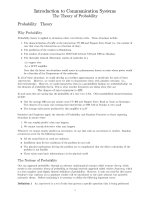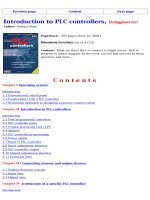Tài liệu Introduction to Telecommunications Network Engineering - Kỹ thuật viễn thông mạng doc
Bạn đang xem bản rút gọn của tài liệu. Xem và tải ngay bản đầy đủ của tài liệu tại đây (3.02 MB, 393 trang )
Introduction to Telecommunications
Network Engineering
Second Edition
Tarmo Anttalainen
Artech House
Boston • London
www.artechhouse.com
Contents
Preface
xv
Acknowledgments
xix
1 Introduction to Telecommunications 1
1.1 What Is Telecommunications? 1
1.2 Significance of Telecommunications 1
1.3 Historical Perspective 3
1.4 Standardization 7
1.5 Standards Organizations 9
1.5.1 Interested Parties 10
1.5.2 National Standardization Authorities 11
1.5.3 European Organizations 11
1.5.4 American Organizations 12
1.5.5 Global Organizations 13
1.5.6 Other Organizations 14
1.6 Development of the Telecommunications Business 15
v
1.7 Problems and Review Questions 17
References 17
2
The Telecommunications Network: An Overview 19
2.1 Basic Telecommunications Network 19
2.1.1 Transmission 20
2.1.2 Switching 20
2.1.3 Signaling 21
2.2 Operation of a Conventional Telephone 22
2.2.1 Microphone 22
2.2.2 Earphone 23
2.2.3 Signaling Functions 23
2.3 Signaling to the Exchange from the Telephone 24
2.3.1 Setup and Release of a Call 24
2.3.2 Rotary Dialing 25
2.3.3 Tone Dialing 26
2.3.4 Local Loop and 2W/4W Circuits 28
2.5 Telephone Numbering 30
2.5.1 International Prefix 31
2.5.2 Country Code 31
2.5.3 Trunk Code, Trunk Prefix, or Area Code 32
2.5.4 Subscriber Number 32
2.5.5 Operator Numbers 32
2.6 Switching and Signaling 33
2.6.1 Telephone Exchange 33
2.6.2 Signaling 34
2.6.3 Switching Hierarchy 37
2.6.4 Telephone Call Routing 38
2.7 Local-Access Network 41
2.7.1 Local Exchange 42
2.7.2 Distribution Frames 43
2.8 Trunk Network 45
vi
Introduction to Telecommunications Network Engineering
2.9 International Network 46
2.10 Telecommunications Networks 47
2.10.1 Public Networks 47
2.10.2 Private or Dedicated Networks 51
2.10.3 Virtual Private Networks 52
2.10.4 INs 53
2.10.5 Public Switched Telecommunications
Network Today 56
2.11 Network Management 58
2.11.1 Introduction 59
2.11.2 Who Manages Networks? 59
2.11.3 DCN 61
2.11.4 TMN 62
2.12 Traffic Engineering 65
2.12.1 Grade of Service 65
2.12.2 Busy Hour 66
2.12.3 Traffic Intensity and the Erlang 67
2.12.4 Probability of Blocking 67
2.13 Problems and Review Questions 72
References 75
3
Signals Carried over the Network 77
3.1 Types of Information and Their Requirements 77
3.2 Simplex, Half-Duplex, and Full-Duplex
Communication 80
3.3 Frequency and Bandwidth 81
3.3.1 Frequency 82
3.3.2 Bandwidth 83
3.4 Analog and Digital Signals and Systems 85
3.4.1 Analog and Digital Signals 85
3.4.2 Advantages of Digital Technology 86
3.4.3 Examples of Messages 88
Contents
vii
3.5 Analog Signals over Digital Networks 91
3.6 PCM 92
3.6.1 Sampling 92
3.6.2 Quantizing 96
3.6.3 Quantizing Noise 97
3.6.4 Nonuniform Quantizing 99
3.6.5 Companding Algorithms and Performance 101
3.6.6 Binary Coding 103
3.6.7 PCM Encoder and Decoder 105
3.7 Other Speech-Coding Methods 106
3.7.1 Adaptive PCM (APCM) 108
3.7.2 Differential PCM (DPCM) 108
3.7.3 DM 109
3.7.4 Adaptive DPCM (ADPCM) 110
3.7.5 Speech Coding of GSM 112
3.7.6 Summary of Speech-Coding Methods 113
3.8 Power Levels of Signals and Decibels 115
3.8.1 Decibel, Gain, and Loss 115
3.8.2 Power Levels 116
3.8.3 Digital Milliwatt 118
3.9 Problems and Review Questions 119
References 124
4
Transmission 125
4.1 Basic Concept of a Transmission System 125
4.1.1 Elements of a Transmission System 125
4.1.2 Signals and Spectra 127
4.2 Radio Transmission 129
4.2.1 CW Modulation Methods 129
4.2.2 AM 129
4.2.3 FM 133
4.2.4 PM 135
4.2.5 Allocation of the Electromagnetic Spectrum 138
viii
Introduction to Telecommunications Network Engineering
4.2.6 Free-Space Loss of Radio Waves 141
4.2.7 Antennas 143
4.3 Maximum Data Rate of a Transmission Channel 144
4.3.1 Symbol Rate (Baud Rate) and Bandwidth 144
4.3.2 Symbol Rate and Bit Rate 146
4.3.3 Maximum Capacity of a Transmission Channel 148
4.4 Coding 151
4.4.1 Purpose of Line Coding 152
4.4.2 Spectrum of Common Line Codes 153
4.5 Regeneration 155
4.6 Multiplexing 158
4.6.1 Frequency-Division Multiplexing (FDM)
and TDM 158
4.6.2 PCM Frame Structure 159
4.6.3 Plesiochronous Transmission Hierarchy 164
4.6.4 SDH and SONET 166
4.7 Transmission Media 170
4.7.1 Copper Cables 170
4.7.2 Optical Fiber Cables 172
4.7.3 Radio Transmission 175
4.7.4 Satellite Transmission 175
4.8 Transmission Equipment in the Network 176
4.8.1 Modems 177
4.8.2 Terminal Multiplexers 177
4.8.3 Add/Drop Multiplexers 177
4.8.4 Digital Cross-Connect Systems 178
4.8.5 Regenerators or Intermediate Repeaters 178
4.8.6 Optical Line Systems 178
4.8.7 WDM 179
4.8.8 Optical Amplifiers 181
4.8.9 Microwave Relay Systems 182
4.9 Problems and Review Questions 183
References 187
Contents
ix
5 Mobile Communications 189
5.1 Cellular Radio Principles 190
5.2 Structure of a Cellular Network 191
5.2.1 Cellular Structure 191
5.2.2 HLR and VLR 192
5.2.3 Radio Channels 193
5.3 Operating Principle of a Cellular Network 194
5.3.1 MS in Idle Mode 194
5.3.2 Outgoing Call 195
5.3.3 Incoming Call 196
5.3.4 Handover or Handoff 196
5.3.5 MS Transmitting Power 196
5.4 Mobile Communication Systems 197
5.4.1 Cordless Telephones 197
5.4.2 PMR (Professional or Private Mobile Radio) 198
5.4.3 Radio Paging 202
5.4.4 Analog Cellular Systems 203
5.4.5 Digital Second Generation Cellular Systems 203
5.4.6 Third Generation Cellular Systems 208
5.4.7 Mobile Satellite Systems 209
5.4.8 WLANs 210
5.4.9 Bluetooth 211
5.5 GSM 212
5.5.1 Structure of the GSM Network 212
5.5.2 Physical Channels 217
5.5.3 Logical Channels 218
5.6 Operation of the GSM Network 219
5.6.1 Location Update 219
5.6.2 Mobile Call 221
5.6.3 Handover or Handoff 223
5.6.4 GSM Security Functions 225
5.6.5 GSM Enhanced Data Services 227
x
Introduction to Telecommunications Network Engineering
5.7 GPRS 228
5.7.1 GPRS Network Structure 229
5.7.2 GPRS Network Elements 230
5.7.3 Operation of GPRS 232
5.8 Problems and Review Questions 233
References 235
6
Data Communications 237
6.1 Principles of Data Communications 237
6.1.1 Computer Communications 238
6.1.2 Serial and Parallel Data Communications 238
6.1.3 Asynchronous and Synchronous Data Transmission 239
6.2 Circuit and Packet Switching 242
6.2.1 Circuit Switching 243
6.2.2 Packet Switching 243
6.2.3 Layer 3 Routing and Routers 245
6.2.4 Switching and Routing Through Virtual Circuits 245
6.2.5 Polling 246
6.3 Data Communication Protocols 248
6.3.1 Protocol Hierarchies 248
6.3.2 Purpose and Value of Layering 250
6.3.3 Open Systems Interconnection (OSI) 251
6.3.4 TCP/IP Protocol Stack 260
6.3.5 Data Flow Through a Protocol Stack 260
6.4 Access Methods 262
6.4.1 Voice-Band Modems 262
6.4.2 ISDN 268
6.4.3 DSL 269
6.4.4 Cable TV Networks 277
6.4.5 Wireless Access 279
6.4.6 Fiber Cable Access 280
6.4.7 Leased Lines and WANs 280
6.5 LANs 281
Contents
xi
6.5.1 LAN Technologies and Network Topologies 282
6.5.2 Multiple-Access Scheme of the Ethernet 284
6.5.3 CSMA/CD Network Structure 284
6.5.4 Frame Structure of the Ethernet 285
6.5.5 CSMA/CD Collision Detection 288
6.5.6 Twisted-Pair Ethernet 292
6.5.7 Switched Ethernet Switches and Bridges 294
6.5.8 Fast Ethernet 296
6.5.9 Autonegotiation 297
6.5.10 Gigabit Ethernet 298
6.5.11 Upgrade Path of the Ethernet Network 299
6.5.12 Virtual LAN 300
6.6 The Internet 301
6.6.1 Development of the Internet 301
6.6.2 Protocols Used in the Internet 302
6.6.3 Bearer Network Protocols for IP 305
6.6.4 Internet Protocol 306
6.6.5 Address Resolution Protocol 315
6.6.6 Routing Protocols 316
6.6.7 ICMP 317
6.6.8 Structure of Internet and IP Routing 318
6.6.9 Host-to-Host Protocols 319
6.6.10 Application Layer Protocols 327
6.6.11 WWW 331
6.6.12 Voice over IP (VoIP) 337
6.6.13 Summary 341
6.7 Frame Relay 342
6.8 ATM 342
6.8.1 Protocol Layers of ATM 343
6.8.2 Cell Structure of ATM 344
6.8.3 Physical Layer of ATM 346
6.8.4 Switching of ATM Cells 347
6.8.5 Service Classes and Adaptation Layer 348
xii
Introduction to Telecommunications Network Engineering
6.8.6 Applications and Future of ATM 350
6.9 Problems and Review Questions 350
References 355
7
Future Developments in Telecommunications 357
7.1 Information Networks 357
7.2 Telephone Services 358
7.3 Wireless Communications 358
7.4 Optical Technology 359
7.5 Digital Broadcast Systems 359
7.6 Summary 360
About the Author 361
Index 363
Contents
xiii
Preface
Telecommunications is one of the fastest growing business sectors of modern
information technologies. A couple of decades ago, to have a basic under-
standing of telecommunications, it was enough to know how the telephone
network operated. Today, the field of telecommunications encompasses a
vast variety of modern technologies and services. Some services, such as
the fixed telephone service in developed countries, have become mature,
and some have been exploding (e.g., cellular mobile communications and
the Internet). The deregulation of the telecommunications industry has
increased business growth, even though, maybe because, tariffs have
decreased.
The present telecommunications environment, in which each of us has
to make choices, has become complicated. In the past, there was only one
local telephone network operator that we chose to use or not use. Currently,
many operators offer us ADSL or cable modem for Internet access and we
have many options for telephone service as well.
Telecommunications is a strategically important resource for most
modern corporations and its importance continues to increase. Special atten
-
tion has to be paid to the security aspects and costs of services. The ever-
changing telecommunications environment provides new options for users,
and we should be more aware of telecommunications as a whole to be able to
capitalize on the possibilities available today.
The business of telecommunications has been growing rapidly, and
many newcomers have found employment in this area. Even if these
xv
newcomers have a technical background, they may feel that they have a very
restricted overall view of the telecommunications network as a whole. The
first purpose of this book is to provide an overall view of telecommunications
networks to newcomers to the telecommunications business. This kind of
general knowledge is useful to the users of telecommunications services, the
personnel of operators, and the employees of telecommunications system
manufacturers.
The professionals working with these complicated technologies very
often have extensive knowledge of one very narrow section of telecommuni
-
cations, but are not familiar with the hundreds of terms and abbreviations
that are used in other telecommunication areas by individuals with whom
they need to interact. One purpose of this book is to provide content to some
of the most common terms and abbreviations used in different areas of
telecommunications.
When I was working as a development department manager at Nokia,
I noticed that relatively few books are available that provide a good intro-
duction to data, fixed, and mobile networks. This kind of overview is valu-
able for people entering a technology area in which all of these technologies
are emerging. Most of the books on the market explain telecommunica-
tions from only one point of view even though there is no longer any
distinct separation of the networks that provide data, speech, and mobile
services.
Everyone working in the modern business environment, such as the
development engineers, testing personnel, and sales managers, must have a
common language if they are to work together efficiently, but not many
books supply that common language because they do not provide an over
-
view of telecommunications as a whole.
The material included in this book is used in the Telecommunica
-
tions Networks course for students of information technologies at the
Espoo-Vantaa Institute of Technology in Finland. The goal of this course
is to give students a basic understanding of the structure and operation of
a global telecommunications network. This course provides an overview
of telecommunications; the provision of a deeper understanding about
each subject, such as the spectral analysis of signals or detailed knowledge
of the operation and functions of mobile networks, is left to dedicated
courses.
I have tried not to cover too many aspects of modern telecommunica
-
tions in this book so as to keep its structure clear. The goal is to lay the basis
for later studies of telecommunications for which many good sources are
available. Some of them are listed at the end of each chapter.
xvi
Introduction to Telecommunications Network Engineering
Objectives
Like the first edition of this book, this second edition is designed to provide
answers to the fundamental questions concerning telecommunications net
-
works and services, telecommunications as a business area, and the general
trends of technical development. These questions include the following:
•
What is the structure and what are the main components of a modern
telecommunications network?
•
What is the importance of standardization and what are the main
standardization bodies for telecommunications?
•
How are analog signals processed for transmission over digital
circuits?
•
What are the basic techniques used in a primary pulse code modula-
tion system that transmits analog speech through the digital tele-
communication network?
•
How does the Integrated Services Digital Network (ISDN) differ
from the ordinary telephone network?
•
What are the fundamental limiting factors of the rate of information
transmission through a transmission channel?
•
How do cellular mobile networks operate and what are their main
components?
•
What are the fundamental differences between circuit and packet
switching techniques?
•
What technical alternatives are available for provision of wideband
access to the Internet?
•
What are local area networks (LANs) and how are connections
arranged over LANs?
•
How does the Internet carry its traffic? What are its protocols and
how do they operate?
•
What happens when I click a mouse on a Web page?
Second Edition
In this second edition, the data communication sections, especially those
dealing with local-area networks and the Internet, have been greatly
expanded. The Internet has become a very important information source for
Preface
xvii
most of us and we use it daily in the office and at home. Its use for various
kinds of commercial service is expanding, and interactive services, including
entertainment, are becoming richer. Most new and evolving network tech
-
nologies for future telecommunications are also based on data communica
-
tion concepts, especially Internet technology. Examples of these are
packet-switched second and third generation cellular systems. Also the core
of the fixed telecommunications network will gradually evolve to packet-
switched networks carrying both data and speech traffic. Here we try to
emphasize this development.
For future development all opinions and comments concerning the
book are welcome. You may send them directly to the author at tarmo.antta
-
For those readers who will use this book as training mate
-
rial, please contact the author for additional teachers’ instructional material.
xviii
Introduction to Telecommunications Network Engineering
Acknowledgments
I want to thank my wife Pirjo and my children Heini, Sini, and Joni for their
patience and understanding while I was writing the book. I am indebted to
my colleagues Matti Puska and Tero Nurminen for their valuable proposals
regarding the development of the book. I also want to thank my students for
their helpful contributions and Espoo-Vantaa Institute of Technology for
the opportunity to complete this project.
xix
.
1
Introduction to Telecommunications
1.1 What Is Telecommunications?
Telecommunications has been defined as a technology concerned with
communicating from a distance, and we can categorize it in various ways.
Figure 1.1 shows one possible view of the different sections of telecommuni-
cations. It includes mechanical communication and electrical communica-
tion because telecommunications has evolved from a mechanical to an
electrical form using increasingly more sophisticated electrical systems. This
is why many authorities such as the national post, telegraph, and telephone
(PTT) companies are involved in telecommunications using both forms.
Our main concern here is electrical and bidirectional communication, as
shown in the upper part of Figure 1.1. The share of mechanical telecommu
-
nications such as conventional mail and press is expected to decrease, whereas
electrical, especially bidirectional, communication will increase and take the
major share of telecommunications in the future. Hence, major press corpo
-
rations are interested in electrical telecommunications as a business
opportunity.
1.2 Significance of Telecommunications
Many different telecommunications networks have been interconnected into
a continuously changing and extremely complicated global system. We look
at telecommunications from different points of view in order to understand
1
what a complicated system we are dealing with and how dependent we are on
it.
Telecommunications networks make up the most complicated equipment in the
world.
Let us think only of the telephone network, which includes more
than 2 billion fixed and cellular telephones with universal access. When any
of these telephones requests a call, the telephone network is able to establish a
connection to any other telephone in the world. In addition, many other net
-
works are interconnected with the telephone network. This gives us a view of
the complexity of the global telecommunications network—no other system
in the world exceeds the complexity of telecommunications networks.
Telecommunications services have an essential impact on the development of a
community.
If we look at the telephone density of a country, we can esti
-
mate its level of technical and economical development. In the developing
2 Introduction to Telecommunications Network Engineering
Telecom-
munications
Electrical
Bidirectional
Unidirectional mass
communication
Post
Press
Radio
TV
Cable TV
Mobile
telephone
Dedicated
networks
Data
networks
Telex
Telegraph
Telephone
Mechanical
Figure 1.1 Telecommunications.
countries the fixed telephone density, that is, the teledensity, is fewer than 10
telephones per 1,000 inhabitants; in developed countries in, for instance,
North America and Europe, there are around 500 to 600 fixed telephones
per 1,000 inhabitants. The economic development of developing countries
depends on (in addition to many other things) the availability of efficient
telecommunications services.
The operations of a modern community are highly dependent on telecommunica
-
tions.
We can hardly imagine our working environment without telecom
-
munications services. The local area network (LAN) to which our computer is
connected is interconnected with the LANs of other sites throughout our
company. This is mandatory so that the various departments can work
together efficiently. We communicate daily with people in other organiza
-
tions with the help of electronic mail, telephones, facsimile, and mobile tele-
phones. Governmental organizations that provide public services are as
dependent on telecommunications services as are private organizations.
Telecommunications plays an essential role on many areas of everyday living.
Everyday life is dependent on telecommunications. Each of us uses telecom-
munications services and services that rely on telecommunications daily.
Here are some examples of services that depend on telecommunications:
•
Banking, automatic teller machines, telebanking;
•
Aviation, booking of tickets;
•
Sales, wholesale and order handling;
•
Credit card payments at gasoline stations;
•
Booking of hotel rooms by travel agencies;
•
Material purchasing by industry;
•
Government operations, such as taxation.
1.3 Historical Perspective
Some of the most important milestones in the development of electrical tele
-
communications systems according to [1] are discussed in this section.
Terms and abbreviations used in the chronology are explained in later chap
-
ters of this book. The development and expansion of some telecommunica
-
tions services is also illustrated in Figure 1.2.
Introduction to Telecommunications
3
1800–1837 Preliminary developments: Volta discovers the primary battery;
Fourier and Laplace present mathematical treatises; Ampere,
Faraday, and Henry conduct experiments on electricity and
magnetism; Ohm’s law (1826); Gauss, Weber, and Wheat-
stone develop early telegraph systems.
1838–1866 Telegraphy: Morse perfects his system; Steinhill finds that the
earth can be used for a current path; commercial service is ini
-
tiated (1844); multiplexing techniques are devised; William
Thomson calculates the pulse response of a telegraph line
(1855); transatlantic cables are installed.
1845 Kirchoff’s circuit laws.
1864 Maxwell’s equations predict electromagnetic radiation.
1876–1899 Telephony: Alexander Graham Bell perfects acoustic trans
-
ducer; first telephony exchange with eight lines; Edison’s
carbon-button transducer; cable circuits are introduced;
Strowger devises automatic step-by-step switching (1887);
Pupin presents the theory of loading.
1887–1907 Wireless telegraphy : Heinrich Hertz verifies Maxwell’s theory;
demonstrations by Marconi and Popov; Marconi patents com
-
plete wireless telegraph system (1897); commercial service
begins, including ship-to-shore and transatlantic systems.
4 Introduction to Telecommunications Network Engineering
AM radio
Wireless telegraph
1850 1930 1970
ISDN
FM radio
Telegraph
Telephone
20051990 2000
Stereo radio
Telefax
Slow WAN
Telex
Fast WAN
TV
Telephone
Paging
Abbreviations:
WAN = Wide Area Network
LAN = Local Area Network
WLAN = Wireless LAN
WWW = World Wide Web
ADSL = Asymmetrical
Digital Subscriber Line
ISDN = Integrated Services
Digital Network
AM = Amplitude Modulation
FM = Frequency Modulation
IP = Internet Protocol
CS = Circuit Switched
PS = Packet Switched
VoD = Video on Demand
LAN
Cordless telephones
Digital radio
Digital TV
ADSL
Mobile
Data
Telefax Gr 4
Time/
year
Cable modems
Internet
WWW
Cellular Telephone
Radio
Digital
Cellular
Telephone
WLAN
Mobile
IP
Stereo TVColor TV
VoD
Figure 1.2 Development of telecommunications systems and services.
1904–1920 Communication electronics: Lee De Forest invents the Audion
(triode) based on Fleming’s diode; basic filter types devised;
experiments with AM radio broadcasting; the Bell System
completes the transcontinental telephone line with electronic
repeaters (1915); multiplexed carrier telephony is introduced:
H. C. Armstrong perfects the superheterodyne radio receiver
(1918); first commercial broadcasting station.
1920–1928 Carson, Nyquist, Johnson, and Hartley present their transmis
-
sion theory.
1923–1938 Television: Mechanical image-formation system demonstrated;
theoretical analysis of bandwidth requirements; DuMont and
others perfect vacuum cathode-ray tubes; field tests and experi
-
mental broadcasting begin.
1931 Teletypewriter service initiated.
1934 H. S. Black develops the negative feedback amplifier.
1936 Armstrong’s paper states the case of frequency modulation (FM)
radio.
1937 Alec Reeves conceives pulse code modulation (PCM).
1938–1945 Radar and microwave systems developed during World War
II; FM used extensively for military communications; hard-
ware, electronics, and theory are improved in all areas.
1944–1947 Mathematical representations of noise developed; statistical
methods for signal detection developed.
1948–1950 C. E. Shannon publishes the founding papers on information
theory.
1948–1951 Transistor devices are invented.
1950 Time-division multiplexing (TDM) is applied to telephony.
Hamming presents the first error correction codes.
1953 Color TV standards are established in the United States.
1955 J. R. Pierce proposes satellite communication systems.
1958 Long-distance data transmission system is developed for mili
-
tary purposes.
1960 Maiman demonstrates the first laser.
1961 Integrated circuits are applied to commercial production.
1962 Satellite communication begins with Telstar I.
Introduction to Telecommunications
5
1962–1966 Data transmission service offered commercially; PCM proves
feasible for voice and TV transmission; theory for digital trans
-
mission is developed; Viterbi presents new error-correcting
schemes; adaptive equalization is developed.
1964 Fully electronic telephone switching system is put into service.
1965 Mariner IV transmits pictures from Mars to Earth.
1966–1975 Commercial satellite relay becomes available; optical links
using lasers and fiber optics are introduced; ARPANET is cre
-
ated (1969) followed by international computer networks.
1976 Ethernet LAN invented by Metcalfe and Broggs (Xerox) [2].
1968–1969 Digitalization of telephone network begins.
1970–1975 PCM standards developed by CCITT.
1975–1985 High-capacity optical systems developed; the breakthrough
of optical technology and fully integrated switching systems;
digital signal processing by microprocessors.
1980–1983 Start of global Internet based on TCP/IP protocol [3].
1980–1985 Modern cellular mobile networks put into service, NMT in
Northern Europe, AMPS in the United States, OSI reference
model is defined by International Standards Organization
(ISO). Standardization for second generation digital cellular
systems is initialized.
1985–1990 LAN breakthrough; Integrated Services Digital Network
(ISDN) standardization finalized; public data communica
-
tions services become widely available; optical transmission
systems replace copper systems in long-distance wideband
transmission; SONET is developed. GSM and SDH stan
-
dardization finalized.
1989 Initial proposal for a Web-linked document on the World
Wide Web (WWW) by Tim Berners-Lee (CERN) [2].
1990–1997 The first digital cellular system, Global System for Mobile Com
-
munications (GSM), is put into commercial use and its break
-
through is felt worldwide; deregulation of telecommunications
in Europe proceeds and satellite TV systems become popular;
Internet usage and services expand rapidly because of the
WWW.
1997–2001 Telecommunications community is deregulated and business
grows rapidly; digital cellular networks, especially GSM,
6 Introduction to Telecommunications Network Engineering
expand worldwide; commercial applications of Internet
expand and a share of conventional speech communications is
transferred from public switched telephone network (PSTN) to
Internet; performance of LANs improves with advance of
gigabit-per-second Ethernet technologies.
2001–2005 Digital TV starts to replace analog broadcast TV; broadband
access systems make Internet multimedia services available to
all; telephony service turns to personal communication service
as penetration of cellular and PCS systems increases; second
generation cellular systems are upgraded to provide higher rate
packet-switched data service.
2005– Digital TV will replace analog service and start to provide
interactive services in addition to broadcast service; third gen
-
eration cellular systems and WLAN technologies will provide
enhanced data services for mobile users; location-based
mobile services will expand, applications for wireless short-
haul technologies in homes and offices will increase; global
telecommunications network will evolve toward a common
packet-switched network platform for all types of services.
1.4 Standardization
Communication networks are designed to serve a wide variety of users who
are using equipment from many different vendors. To design and build net
-
works effectively, standards are necessary to achieve interoperability, com
-
patibility, and required performance in a cost-effective manner.
Open standards are needed to enable the interconnection of systems,
equipment, and networks from different manufacturers, vendors, and opera
-
tors. The most important advantages and some other aspects of open tele
-
communications standards are explained next.
Standards enable competition.
Open standards are available to any telecom
-
munications system vendor. When a new system is standardized that is at
-
tractive from a business point of view, multiple vendors will enter this new
market. As long as a system is proprietary, specifications are the property of
one manufacturer and it is difficult, if not impossible, for a new manufac
-
turer to start to produce compatible competing systems. Open competition
makes products more cost-effective, therefore providing low-cost services to
telecommunications users.
Introduction to Telecommunications
7
Standards lead to economies of scale in manufacturing and engineering.
Stan
-
dards increase the market for products adhering to the standard, which leads
to mass production and economies of scale in manufacturing and engineer
-
ing, very large scale integration (VLSI) implementations, and other benefits
that decrease price and further increase acceptance of the new technology.
This supports the economic development of the community by improving
telecommunications services and decreasing their cost.
Political interests often lead to different standards in Europe, Japan, and the
United States.
Standardization is not only a technical matter. Sometimes
opposing political interests make the approval of global standards impossible,
and different standards are often adapted for Europe, the United States, and
Japan. To protect local industry, Europe does not want to accept American
technology and America does not want to accept European technology.
One example of a political decision in the 1970s was to define a differ-
ent PCM coding law for Europe instead of the existing American PCM code.
(We will explain this terminology in Chapter 3.) A more recent example is
the American decision in the 1990s not to accept European GSM technology
as a major digital second generation cellular technology.
International standards are threats to the local industries of large countries but
opportunities to the industries of small countries.
Major manufacturers in
large countries may not support international standardization because it
would open their local markets to international competition. Manufacturers
in small countries strongly support global standardization because they are
dependent on foreign markets. Their home market is not large enough for
expansion and they are looking for new markets for their technology.
Standards make the interconnection of systems from different vendors possible.
The main technological aim of standardization is to make systems from
different networks “understand” each other. Technical specifications
included in open standards make systems compatible and support the provi
-
sion of wide-area or even global services that are based on standardized
technology.
Standards make users and network operators vendor independent and improve
availability of the systems.
A standardized interface between a terminal and
its network enables subscribers to purchase terminal equipment from multi
-
ple vendors. Standardized interfaces among systems in the network enable
network operators to use multiple competing suppliers for systems. This
improves the availability and quality of systems and reduces their cost.
8 Introduction to Telecommunications Network Engineering
Standards make international services available.
Standardization plays a key
role in the provision of international services. Official global standards de
-
fine, for example, telephone service, ISDN, and facsimile. The standards of
some systems may not have official worldwide acceptance, but if the system
becomes popular all around the world, a worldwide service may become
available. Recent examples of these services are GSM and the Internet with
WWW. Internet specifications have no official status, and GSM was origi
-
nally specified for Europe only. Their specifications have been openly avail
-
able, which has supported their expansion.
To clarify and understand the influence of standardization on our eve
-
ryday lives, consider these examples of international standardization:
•
Screw thread pitches (ISO, Technical Committee 1): This was one of the
first activity areas of standardization. In the 1960s, a bolt from one car
would not fit another. Currently, bolts are internationally standard-
ized and most often compatible.
•
International telephone numbering and country codes: Without glob-
ally unique identification of subscribers, automatic international
telephone calls would not be available.
•
Telephone subscriber interfaces.
•
PCM coding and primary rate frame structure: This coding and struc-
ture make national and international digital connections between
networks possible.
•
Television and radio systems.
•
Frequencies used for satellite and other radio communications.
•
Connectors and signals for PC, printer, and modem interfaces.
•
LANs: These enable people to use computers from any manufacturer
in a company network.
•
Cellular telephone systems: Enable users to choose a handset from
among a large selection with different features from many different
vendors.
1.5 Standards Organizations
Many organizations are involved in standardization work. We look at them
from two points of view: (1) the players in the telecommunications business
Introduction to Telecommunications
9









